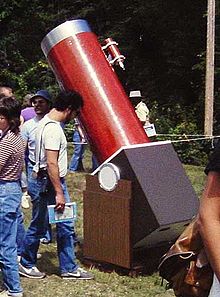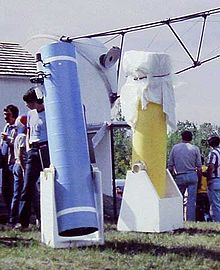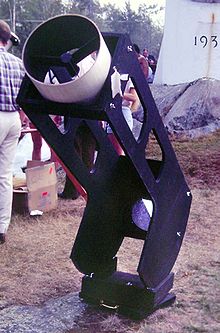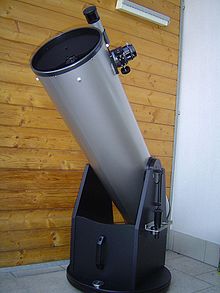- Dobsonian telescope
-
 A Dobsonian telescope on display at Stellafane in the early 1980s
A Dobsonian telescope on display at Stellafane in the early 1980s
A Dobsonian telescope is an alt-azimuth mounted newtonian telescope design popularized by the amateur astronomer John Dobson starting in the 1960s. Dobson's telescopes featured a simplified mechanical design that was easy to manufacture from readily available components to create a large, portable, low-cost telescope. The design is optimized for visually observing faint deep sky objects such as nebulae. This type observation requires a large objective diameter (i.e. light-gathering power) of relatively short focal length and portability for travel to relatively less light polluted locations.[1][2]
Dobsonians are intended to be what is commonly called a "light bucket"[3] operating at low magnification, and therefore the design omits features found in other amateur telescopes such as equatorial tracking. Dobsonians are popular in the amateur telescope making community, where the design was pioneered and continues to evolve.[1] A number of commercial telescope makers also sell telescopes based on this design. The term "Dobsonian" is currently used for a whole range of large-aperture Newtonian reflectors that use some of the basic dobsonian design characteristics, regardless of the materials from which it was constructed.[4]
Contents
Origin and design
It is hard to classify the Dobsonian Telescope as a single invention. In the field of amateur telescope making most, if not all, of its design features had been used before. John Dobson, credited as having invented this design in the 1950s,[5] points out that "for hundreds of years, wars were fought using cannon on 'Dobsonian' mounts". Dobson himself identified the characteristic features of the design as lightweight objective mirrors made of porthole glass, and mountings constructed from plywood, Teflon strips and other low-cost materials.[4] Since he built these telescopes as aids in his avocation of instructional sidewalk astronomy, he prefers to call the design a "sidewalk telescope".[6] It appears that John Dobson simply combined all these innovations in a design that is focused towards one goal: building a very large, inexpensive, easy to use, portable[7] telescope for the sole purpose of visual observing of astronomical objects as a way to bring astronomy to the masses.[8]
Dobson's design innovations
Dobson's design allows a builder with minimal skill to make an extremely large telescope out of common items. Dobson optimized the design for visual observation of faint objects such as star clusters, nebulae, and galaxies (what Amateur Astronomers call deep sky objects). These dim objects require a large objective mirror able to gather a large amount of light. Because "deep sky" observing often requires travel to dark locations away from city lights, the design benefits from being more compact, portable, and rugged than standard large Newtonian telescopes. John Dobson's telescopes combined several innovations to meet these criteria, including:
- Thin mirrors: Instead of costly Pyrex mirror blanks with the standard 1:6 thickness ratios[1] (1 cm thick for every 6 cm in diameter) so they won't flex and sag out of shape under their own weight, Dobson used mirrors made out of surplus glass ship porthole covers usually with 1:16 thickness ratios.[9] Since the telescope design has an alt-azimuth mount the mirror only has to be supported in a simple cell with a backing of indoor/outdoor carpet to evenly support the weight of the much thinner mirror.
- Construction tubes: Dobson replaced the traditional aluminum or fiberglass telescope tube with the thick compressed paper tubes used in construction to pour concrete columns. Sonotubes, the leading brand employed by Dobson, are less expensive than commercially available telescope tubes and are available in comparatively large sizes. Dobsonian scopes are intended to be transported out to dark sky locations, and Sonotubes are claimed to be more rugged than aluminum or fiberglass tubes which can dent or shatter from impacts. Sonotubes have the added advantage of being thermally stable and non-conductive which minimize unwanted convection currents in the light path caused by handling of the tube assembly.
- A square "mirrorbox": Dobson used a plywood box for the tube base and mirror housing. This gave a rigid flat surface to attach the "carpet" support for the porthole mirrors he was using, and made it easy to attach the altitude bearings.
- A simple alt-azimuth mount: Dobson opted for a simple to build and use altazimuth mount. He used a “gun carriage type” design consisting of a flat platform ("ground board") on which sits a rotating box with semicircular depressions cut in the top for the altitude bearings ("rocker" or "rocker box"). All parts were made from plywood and other common materials. For the azimuth (side-to-side) motion Dobson used a combination of Teflon blocks turning on a flat Formica covered surface. For the altitude (up-and-down) motion, Dobson used a large diameter axle "closet flange" turning on Teflon bearing blocks attached to the altitude cutouts. Dobson's use of Teflon on all bearing surfaces and the large diameter of the bearings created a smooth action with a moderate amount of friction, so that a clamp mechanism is not necessary to prevent unintentional motion of the telescope.
The design of Dobsonian telescopes has evolved over the years (see Derivative Designs), but most commercial or amateur-built "Dobsonian" telescopes follow many or most of the design concepts and features listed above.
Applications
Advantages
- Maximized objective diameter
-
- Low mass to objective size ratio: The Dobsonian design's structure as measured in volume and weight is relatively minimal for any given objective diameter when compared to other designs.[10]
-
- Low cost to objective size ratio: From a cost perspective, a user typically gets more objective diameter per unit of cost with the Dobsonian design.[11]
- Simplicity and Portability: Transporting, setting up, and operating a Dobsonian telescope is simpler than for many other designs. The mount system is compact. Setting up for hard tube dobs simply involves placing the mount on the ground, and setting the tube on top of it. The altazimuth mount is easy to point. The weight of the Dobsonian is distributed over large simple bearing surfaces so the telescope can move smoothly under finger pressure with minimal backlash.
- Good "Deep Sky" telescope: The Dobsonian design of maximized objective diameter combined with portability makes the design ideal for observing dim deep sky objects, an activity that requires large objectives and travel to dark sky locations. Since these objects are relatively large they are observed at low magnifications that do not require a clock-driven mount.
Limitations
- Non equatorial mount: Because the Dobsonian design is optimized to be a portable, large aperture, inexpensive, deep sky instrument geared towards visual observing, an expensive (and massive) equatorial telescope mount with clock drive was intentionally left out of the design.[12] Instead, with an Altazimuth mount, the user must nudge the scope every few minutes along both axes to compensate for the rotation of the Earth to keep an object in view. The Altazimuth mount also does not allow for the use of conventional setting circles to help in aiming the telescope at the coordinates of known objects.
- Zenithal Hole: Altazimuth mounts are known for being difficult to point at objects near the zenith, mainly because a large movement of the azimuth axis is needed to move the telescope pointing by even a small amount. Improvements in the azimuth bearing material and design can minimize the problem, but not eliminate it. Equatorially-mounted telescopes have a similar issue when observing objects near the celestial poles.
- Balance Issues: Since the telescope tube is usually fixed in relationship to its altitude bearings, the addition or subtraction of equipment such as cameras, finderscopes or even unusually heavy eyepieces can render the telescope mount unbalanced unless a counterweight or similar modification is added. However, most Dobsonian telescopes have enough friction in the bearings to resist a moderate amount of imbalance.
Derivative designs
From its inception, telescope makers have been modifying the Dobsonian design to fit their needs. The original design fit the needs and available supplies of one person—John Dobson. Other people devised variants that fit their own needs, abilities, and access to parts. This has led to significant diversity in "Dobsonian" design.
Collapsible tube assemblies
“Classic” design tube assemblies would require a large van for transport. Designers started coming up with disassembleable or collapsible variants that could be brought to the site with a small SUV, hatchback, or even a sedan. This innovation allowed the amateur astronomy community access to even larger apertures.
The truss tube
Many designs have combined the advantages of a light truss tube and a collapsible design. Collapsible "truss tube" dobsonians appeared in the amateur telescope making community as early as 1982[13][14] and allow the optical tube assembly, the largest component, to be broken down. As the name implies, the "tube" of this design is actually composed of an upper 'cage assembly', which contains the secondary mirror, and focuser, held in place by several rigid poles over a ‘mirror box’ which contains the objective mirror. The poles are held in place by quick-disconnecting clamps which allow the entire telescope to be easily broken down into its smaller components, facilitating their transport by vehicle or other means to an observing site. These truss tube designs are sometimes incorrectly called a Serrurier truss, although since the main truss is not built with an opposing mirror cell truss it only performs one function of that design, i.e. keeping the optics parallel.
Modifications to the altazimuth mount (rocker box)
The main attribute of a Dobsonian's mount is that resembles a "gun carriage" configuration with a "rocker box" consisting of a horizontal trunnion style altitude axis and a broadly supported azimuth axis, both making use of material such as plastic, Formica, and Teflon to achieve smooth operation.[15] Many derivative mount designs have kept this basic form while heavily modifying the materials and configuration.
Compact “rocker box” mounts
Many designs have increased portability by shrinking the altazimuth (rocker box) mount down to a small rotating platform. The altitude trunnion style bearing in these designs becomes a large radius roughly equal to or greater than the radius of the objective mirror, attached to or integrated into the tube assembly which lowers the overall profile of the mount. The advantage of this is that it reduces the total telescope weight, and the telescope's balance becomes less sensitive to changes in the weight loading of telescope tube from the use of heavier eyepieces or the addition of cameras etc.
Overcoming the limitations the altazimuth mount
Since the late 1990s many innovations in mount design and electronics by amateurs telescope makers and commercial manufacturers have allowed users to overcome some of the limitations of the Dobsonian style altazimuth mount.
- Digital setting circles: The invention of microprocessor based digital setting circles has allowed any altazimuth mounted telescope to be fitted or retrofitted with the ability to accurately display what are the coordinates of the telescope direction.
- Equatorial platform: The use of equatorial platforms (such as the Poncet Platform) fitted under the altazimuth mount has given users limited equatorial tracking for visual and astrophotographic work. Such platforms can incorporate a clock drive for ease of tracking.
Commercial adaptations
The intent of the Dobsonian design when it was first originated in the 1960s was to provide affordable extremely simple and rugged large-aperture instrument at low cost.[16] These same attributes facilitate their mass production. One of the first companies to offer the Dobsonian commercially was the now defunct company Coulter Optical (now part of Murnaghan Instruments). They helped popularize the design with models in the 8 inch through 17.5 inch size range in the 1980s and 1990s that were built using Dobson's original concept. Meade Instruments and other manufacturers began to introduce their variation on this design by the late 1990s. Although manufactured scopes include such niceties as metal tubes and more refined hardware, these telescopes are still extremely affordable. In late 2006, 6 inch models cost around $300 US and 10 to 12 inches (250 to 300 mm) scopes can still be had for under $1,000 US.
Since the late 1990s, Dobsonians using the truss tube design became increasingly popular with manufacturers. In 1989, the first commercial truss tube Dobsonian was released by Obsession Telescopes into the market.[citation needed] Manufacturers of these truss tube Dobsonians have differentiated themselves by going in the opposite direction from John Dobson's original intent by catering toward the upper end of the market and more experienced observers. These telescopes came with full thickness mirrors and use higher end materials such as Baltic birch or similar plywood and cast aluminum fittings. These designs also employed the "rocker box" mount listed above.
As of the early 2000s these truss tube Dobsonians are the largest commercially available telescopes, with three manufacturers offering models in the 24 inches (610 mm) to 30 inches (760 mm) range (hard tube and other reflector designs typically stop at 18 inches (460 mm) due to the size of the tube). As of March 2010, Orion Telescopes & Binoculars offers the largest commercially available trus tube Dobsonian, a 50" aperture model.[17] As these scopes require teams of several people to operate and require the observer to perch on top of a ladder, the markets for these scopes is limited. Telescopes with a 15 to 18 inches (380 to 460 mm) aperture appear to be the most popular size, as they maximize the amount of aperture yet can still be easily be set up by one person. In early 2009 prices can range from $800 for a 12" instrument to $3500 plus for 18" or larger instruments, depending on the quality and features.
The Dobsonian's effect on amateur astronomy
The inherent simplicity and large aperture of the design began to attract interest through the 1970s since it offered the advantage of inexpensive large instruments that could be carried to dark sky locations and even star parties in the back of a small car and set up in moments. The result has been a proliferation of larger telescopes which would have been expensive to build or buy, and unwieldy to operate, using "traditional" construction methods. Whereas an 8-inch Newtonian telescope would have been considered large 30 years ago, today 16-inch systems are common, and huge 32-inch systems not all that rare.
In combination with other improvements such as narrow-pass filters and improved eyepieces, the large apertures of the Dobsonian have dramatically increased the depth to which an amateur astronomer can penetrate into the universe. Whereas the amateur astronomer of the 1970s and 1980s typically did not explore much beyond the Messier and brighter NGC objects, the amateur astronomer of today can routinely observe objects in the IC, Abell, Perek Kohoutek, Minkowski and other obscure catalogues once considered the domain of professional astronomers, thanks in part to Dobsonians.
Notes
- ^ a b c Jack Newton, Philip Teece - "The Guide to Amateur Astronomy" - Page 287
- ^ Timothy Ferris "Seeing in the Dark" - Page 39
- ^ Mark Allison "Star Clusters and how to Observe Them" Page 74
- ^ a b "Walden of the Sky". Sky & Telescope: 84–87. September 1995.
- ^ Chris DiBona, Mark Stone, Danese Cooper "Open Sources 2.0" - Page 351
- ^ Fred Watson "Why is Uranus Upside Down?", Inc NetLibrary - Page 17
- ^ Peter Knoll "Induced Seismic Events" - Page 25
- ^ David H. Albert "And the Skylark Sings with Me" - Page 93
- ^ Jack Newton, Philip Teece - "The Guide to Amateur Astronomy" - Page 288
- ^ This ratio ensures that per inch of objective diameter, a Dobsonian will weigh less and require less space than other types and is thus the most portable design.
- ^ South East Queensland Astronomical Society Inc., Recommendations for Beginning Amateur Astronomers, page 4.
- ^ Peter Knoll "Induced Seismic Events" - Page 25 "Dobson....promoting causal visual observing."
- ^ "An Extremely Portable 17½" Dobsonian" by Ivar Hamberg, Telescope Making No. 17 (Fall 1982)
- ^ telia.com The 17.5" Dobsonian by Ivar Hamberg
- ^ Jack Newton, Philip Teece, The guide to amateur astronomy, page 289
- ^ Dobson, John L. (1991). How and Why to Make a User-Friendly Sidewalk Telescope. Everything in the Universe. pp. 61–62. ISBN 0-913399-63-9.
- ^ gadgetytech.com, Orion’s Monster Dobsonian Telescope Will Be the Talk of Your Backyard Cookout, by Dave Peterson - January 9, 2010
See also
References
- Smithsonianmag.com - 35 Who Made a Difference: John Dobson By Don Moser November 1, 2005
- "A Salesman For The Heavens Wants To Rope You In", By Don Moser, Smithsonian Magazine April 1989. abstract
- San Francisco Sidewalk Astronomers
- "The New Amateur Astronomer" by Martin Mobberley - 2004 - page 21 [1]
- "Induced Seismic Events" By Peter Knoll - Page 25 [2]
- "And the Skylark Sings with Me" By David H. Albert - Page 92 [3]
- "Firefly Astronomy Dictionary" By John Woodruff - Page 60 [4]
- "The Guide to Amateur Astronomy" By Jack Newton, Philip Teece - Page 287 [5]
- "Seeing in the Dark" By Timothy Ferris - Page 37 [6]
- "Open Sources 2.0" By Chris DiBona, Mark Stone, Danese Cooper - Page 351 [7]
Books on Dobsonians and other published information
- John Dobson, How and Why to Make a User-Friendly Sidewalk Telescope edited by Norman Sperling ISBN 0-913399-64-7 The book treats the "why" as importantly as the "how", sharing Dobson's philosophy on the importance of popular access to astronomy for proper appreciation of the universe.
- David Kriege, Richard Berry, The Dobsonian Telescope: A Practical Manual for Building Large Aperture Telescopes, 1997, Willmann-Bell, ISBN 0-943396-55-7
External links
Categories:- Telescope types
Wikimedia Foundation. 2010.




